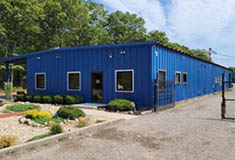Office market continues positive momentum - by Darren Leiderman
The L.I. office market fundamentals continued the positive momentum despite at a slower pace in Q4 2016. The L.I. labor market remains a record low at 4.1%, a 0.1% decrease from Q3 but was on par with a year ago. Q3 GDP boomed at a 3.5% annual rate, the fastest pace in the past two years. It is projected that L.I.’s economy will grow 1.5% to 2.2% in 2017 with the booming consumer spending.
The market is in a wait-and-see state but the outlook is positive with the expected effects of the 2016 U.S. Presidential election. Under President Trump’s Administration, the commercial real estate performance and fundamentals are expected to strengthen with tax cuts and infrastructure spending. Interest rates are expected to rise and the anti-globalization would impede domestic consumer spending and foreign investments. However, these forecasts of impacts from the Trump Administration are still in the preliminary stage; the actual effects should reply on the enactment of new policies under the Trump Administration. Above all, no matter how the policies would change, the effects for the commercial real estate would still be positive with the strong economic fundamentals and insightful perspectives from a real estate mogul.
The Q4 overall vacancy rates increased to 8.6% for the first time in 2016 picking up from a record low of 8.3% in Q3 2016. Likewise, the vacancy rates for class A buildings rebounded to 8.6% in Q4 from 7.8% in Q3 the lowest rate since 2000. The Q4 average gross asking rents continued to grow to $26.82 per s/f, a 0.19% increase from Q3. The rental rates for class A buildings yet decreased 1.64% to $30.63 per s/f in Q4.
The L.I. net absorption recorded negative 151,833 s/f in Q4 with year-to-date absorption of 307,223 s/f.
Leasing activity was up 34.5% to 519,444 s/f in Q4 2016, a 17% increase year-over-year. The total sales transaction volume for all office classes reached $73.9 million and $366.8 million in 2016. The Q4 average sales price stood at $192 per s/f for class A buildings and $170 per s/f for both class A and B buildings.
Vacancy
Q4 inventory ending December 31 added 0.2 million s/f to 61.3 million s/f for class A & B buildings. The Long Island vacancy rates stood at 8.6%, 30 bps increase from Q3 driven by the slower pace of the market. However, Nassau County continued the momentum with the vacancy rates dipping to 7.6%, a 0.3% decrease from Q3. Suffolk County saw a higher vacancy rate of 9.8% in Q4.
Rental Rate
The Q4 Long Island average gross rental rates for class A & B buildings continued to strengthen, reaching $26.82 psf in Q4, 0.19% up from Q3 and nearly 1% up year-over-year. The rental rates for Nassau County declined 0.96% to $29.87 per s/f in Q4 yet Suffolk County registered gains of 0.98% to $23.62 per s/f in Q4. However, driven by the cool-off market, the rental rates for class A properties dropped slightly to $30.63 per s/f, 1.64% down from Q3.
Absorption
The Long Island office market had negative absorption of 151,833 sf, down from a robust growth in Q3. The YTD net absorption has reached 307,223 sf which was only one third of the total absorption in 2015. Suffolk County in Q4 experienced a severe loss with negative 252,864 sf absorbed. Nassau County cut nearly half from Q3. The Western Nassau submarket still made gains with an increasing net absorption reading 62,146 sf however the Western Suffolk submarket marked a significant drop to negative 222,551 sf in Q4 accompanied with the large vacancies in this submarket.
Outlook
Throughout 2016, the Long Island office market performed well with strong market fundamentals and economic indicators despite the market slowed after the peaking year of 2015. Amid steady job growth and renewed GDP, the Long Island office market will post a moderate growth and rebound to the equilibrium level in 2017. The overall market responded positively following the November election however the actual effects are still in a wait-and-see stage.
Under the Trump Administration, the new proposed policies such as tax cuts would boost the growth of US economy. However anti-globalization would hurt the domestic consumer spending to the extent to the real estate business. Nevertheless, these effects will not appear until the new political decisions are made under the new government. The outlook for 2017 is positive and would not have unexpected exogenous shock to the economy.
Darren Leiderman is the executive vice president, Lake Success, N.Y.
Suffolk County IDA supports expansion of A&Z Pharmaceuticals


The evolving relationship of environmental consultants and the lending community - by Chuck Merritt
When Environmental Site Assessments (ESA) were first part of commercial real estate risk management, it was the lenders driving this requirement. When a borrower wanted a loan on a property, banks would utilize a list of “Approved Consultants” to order the report on both refinances and purchases.










.jpg)